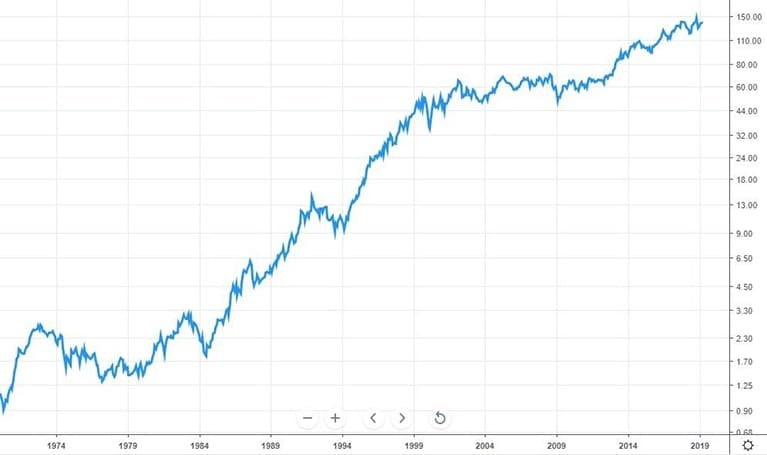

What are Blue-Chip Stocks?
Definition: What are blue-chip stocks?
Although there's no precise definition of what blue-chip stocks are, the term is used to refer to the stocks of well-established, profitable and big companies. In general, these companies have existed for a long time, offer well-known products and brands and represent the market leaders in their respective industries. In addition, quite often, such companies are multinational corporations with branches in many countries.
The term "blue chip" has actually been borrowed from poker because the blue poker chips have the highest value. The term was first used in the 1920s to refer to the stocks of big, well-established and profitable companies.
Finally, almost all blue-chip stocks are included in the major stock indices, such as the Dow 30, S&P 500 and FTSE 100.

Some examples of blue-chip stocks
Below you can find examples of well-known blue-chip stocks. They aren't necessarily the biggest or best blue chips but a cross-selection of examples from different industries.
|
Company |
Share price (as of 16 May 2022) |
Market capitalisation (billions) |
|
$261.50 |
$1,952.93 |
|
|
$145.54 |
$2,355 |
|
|
$2,216.21 |
$1,127 |
|
|
$178.08 |
$468.59 |
|
|
$118.26 |
$347.34 |
|
|
$90.95 |
$384.32 |
|
|
$197.81 |
$378.79 |
|
|
Walmart |
$148.21 |
$407.98 |
|
$34.81 |
$280.46 |
|
|
$50.67 |
$286.17 |
|
|
Merck and Co. |
$92.32 |
$228.63 |
|
$124.05 |
$73.39 |
|
|
$65.96 |
$284.90 |
|
|
$105.18 |
$195.49 |
|
|
$244.04 |
$180.47 |
|
|
$72.42 |
$83.06 |
You'll probably know most, if not all, of these companies. You might also notice that they are leaders in their respective industries, and have been on the market for 40 years or even longer.
The pros and cons of investing in blue-chip stocks

Blue-chip companies have a proven business model and have used their retained earnings to grow further. Most of them also have a big competitive advantage. This makes it very difficult for other competitors to encroach on their market stocks.
Unlike blue-chip stocks, those of companies not considered blue chips are often traded at prices that reflect their future potential and not the actual balance profits. If this potential is not realised, the stock price must adjust at some point.
The biggest drawback of blue chips is that they don't grow as fast as smaller companies. Every year, technology companies' stocks outperform blue chips, though it comes with increased volatility and risk.
Finally, some blue-chip companies are going bankrupt. Probably due to changes in technology or consumption trends. Manufacturers of analogue cameras and cars are examples of companies that aren't what they used to be. Many traditional retail chains are currently in a downward spiral.
For this reason, potential investors should always ask themselves whether there'll be such an industry in the future before investing in a company in this sector.
How to invest in blue-chip stocks
There are several ways to invest in blue chips. Besides actually buying the stocks, you can also buy CFDs, futures, options and even binary options on the respective stock.
Click here to learn more about trading stocks.
Buying and owning blue-chip stocks
The traditional approach is to actually buy the stocks of blue-chip companies and own them over a long period of time. That's what Warren Buffet, the most famous investor in the world, is doing.
There are some pros and cons to this approach. When you own stocks in a company that makes steady profits over time, the company will reinvest those profits. This can lead to bigger revenues for the company, so the numbers could really go up a lot by doing this.
Trading blue-chip stocks

Actively trading blue-chip stocks can be successful if done right (Following all the steps and instructions does not give a 100% guarantee of success, but you can gain experience and become better at trading skills). While the stock price is usually not that volatile, there are speculative stocks, which carry a lot more risk.
The price movement is also much more predictable. The stocks are sometimes overbought and too expensive, which ultimately leads to a price decline. However, big institutional funds are always looking for blue-chip stocks if they can get them at good prices.
As a trader, you just have to wait for the price to fall low enough and then make sure that the buying volume increases and the price goes up. This gives traders an asymmetric bet, with limited downside risk but with significantly larger upside potential.
Traders can potentially profit by switching from one blue-chip to the next promising one. They buy them at a low price when they see an increased buying volume and then ride the trend until the price stops rising. Then they look for the next cheap blue-chip stock that they can buy.
Futures contracts
Futures are exchange-traded derivative contracts that allow traders to leverage and trade long and short positions. Futures contracts can be traded on stock indices, commodities, bonds and even on big liquid blue-chip stocks. They allow active traders to increase their position size without investing more capital. Of course, this kind of trading increases both the profits and losses. However, when you apply disciplined risk management, it can be more profitable than trading the stock itself.
The downside of futures contracts (in addition to the increased risk) is that the contract size is usually too big for most retail clients. In addition, an account with a dedicated futures broker is required in most cases.
Contract for Difference (CFDs)
CFDs are another type of derivative similar to futures contracts, even though they aren't traded on exchanges. CFDs can be traded directly with banks and brokers. In most other respects, they're similar to futures contracts but have smaller contract sizes. They are often as small as a stock contract.
CFDs are ideal for both beginners and experienced traders. They allow traders to leverage by trading on the margin and trade both long and short positions. CFDs are therefore ideal for those who want to actively trade blue-chip stocks.
Exchange Traded Funds (ETFs)
ETFs are baskets of stocks traded on exchanges, like the stocks they include. In most cases, an ETF tracks an index such as the Dow Jones Industrial Average, Nasdaq or FTSE 100.
Since most major stock market indices consist mainly of blue-chip stocks, ETFs offer traders a vehicle to trade a group of blue chips in just one shot. ETFs are less volatile and less risky than individual stocks, but they can also be traded via CFDs and other leveraged derivatives.
Binary options
Binary options are also a kind of derivative, but they have limited risk in case you're the buyer. A binary option is like a bet on whether something will happen or not. It'll either result in a big profit or become worthless. These instruments can be traded on different markets and over different time periods.
For those who like to bet on the stock price of blue chips that they will reach a certain level at a given time or date, binary options should definitely be considered. However, caution and a reasonable risk management strategy are always advisable.
Summary
Blue chips can provide steady gains over time, with great options for active traders. There are also many different instruments that traders can use to trade blue chips, depending on their personal style of trading.Remember that such trading can lead to a loss also and profits are not guarantee.
Libertex is a broker and trading platform that offers CFDs on 50 US and European stocks, most of which are considered blue chips. In addition, clients can trade CFDs on commodities, indices, ETFs and cryptocurrencies with leverage. But please note that trading CFDs with leverage can be risky and can lead to losing all of your invested capital. To try out what it's like to trade blue-chip stocks without risking actual capital, you can always open a demo account.
Disclaimer: The information in this article is not intended to be and does not constitute investment advice or any other form of advice or recommendation of any sort offered or endorsed by Libertex. Past performance does not guarantee future results.
Why trade with Libertex?
- Get access to a free demo account free of charge.
- Enjoy technical support from an operator 5 days a week, from 9 a.m. to 9 p.m. (Central European Standard Time).
- Use a multiplier of up to 1:30 (for retail clients).
- Operate on a platform for any device: Libertex and MetaTrader.